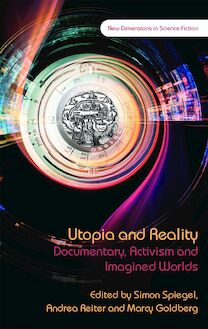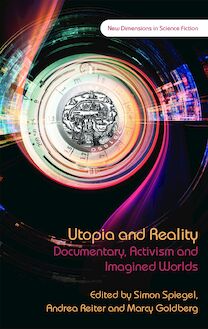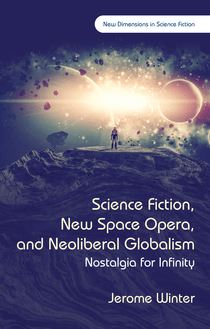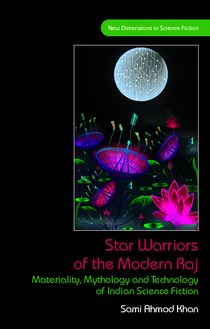Star Warriors of the Modern Raj , livre ebook
157
pages
English
Ebooks
2021
Vous pourrez modifier la taille du texte de cet ouvrage
Obtenez un accès à la bibliothèque pour le consulter en ligne En savoir plus
Découvre YouScribe en t'inscrivant gratuitement
Découvre YouScribe en t'inscrivant gratuitement
157
pages
English
Ebooks
2021
Vous pourrez modifier la taille du texte de cet ouvrage
Obtenez un accès à la bibliothèque pour le consulter en ligne En savoir plus
Publié par
Date de parution
15 juin 2021
Nombre de lectures
2
EAN13
9781786837646
Langue
English
India is mutating – and its Science Fiction with it. Star Warriors of the Modern Raj is a critical catalogue of contemporary India’s anglophone SF, a path-breaking work that flits between texts, vantage points and frameworks. An alternative to a Eurocentric perspective of SF, this study avoids essentialising definitions and delves into how the world of SF (text) intersects with that of the writer/reader. Fusing paradigms of Science Fiction Studies, South Asian Studies and Postcolonial Studies, among others, the book explicates how India and its SF negotiate one another. It evolves a ‘transMIT thesis’ to analyse how mythology (M), ideology (I) and technology (T) contour Indian SF and its fictional reimaginings. This study identifies the manifestations of divine beings within SF as differing epistemological categories, locates the modes of marginalisation within Indian popular imagination as altars of alterity, before proceeding to analyse how newer technologies engage with socio-political anxieties in and through SF.
Interested in learning about Science Fiction and South Asia? Click on the link below to read Mithila Review interview with Sami Ahmad Khan where he discusses his upcoming volume Star Warriors of the Modern Raj. https://mithilareview.com/ahmad_03_21/
Author’s Note
List of Illustrations–– 3 (‘IN situ Model’, ‘transMIT thesis’ and ‘TIMography’)
List of Tables–– 1 (ISFE’s Soul)
Content Acknowledgements
Part I (SF-101)
Part II (Materiality)
Section Prologue: The Altar of Alterity
Section Epilogue: The Materiality Menace
Part III (Mythology)
Section Prologue: Hey Bhagwan, the ET has Landed!
Section Epilogue: Revenge of the Myth
Part IV (Technology)
Section Prologue: Beat, Prey, Love
Section Epilogue: The Technology Awakens
Part V (Conclusion)
Works Cited
Glossary
Publié par
Date de parution
15 juin 2021
Nombre de lectures
2
EAN13
9781786837646
Langue
English
New Dimensions in Science Fiction
Star Warriors of the Modern Raj
New Dimensions in Science Fiction
Series Editors
Professor Pawel Frelik
University of Warsaw
Professor Patrick B. Sharp
California State University, Los Angeles
Editorial Board
Grace Dillon
Portland State University
Tanya Krzywinska
Falmouth University
Isiah Lavender III
University of Georgia
Roger Luckhurst
Birkbeck University of London
John Rieder
University of Hawai’i
Star Warriors of the Modern Raj
Materiality, Mythology and Technology of Indian Science Fiction
Sami Ahmad Khan
© Sami Ahmad Khan, 2021
All rights reserved. No part of this book may be reproduced in any material form (including photocopying or storing it in any medium by electronic means and whether or not transiently or incidentally to some other use of this publication) without the written permission of the copyright owner except in accordance with the provisions of the Copyright, Designs and Patents Act 1988. Applications for the copyright owner’s written permission to reproduce any part of this publication should be addressed to the University of Wales Press, University Registry, King Edward VII Avenue, Cardiff CF10 3NS.
www.uwp.co.uk
British Library CIP Data
A catalogue record for this book is available from the British Library.
ISBN 978-1-78683-762-2
eISBN 978-1-78683-764-6
The right of Sami Ahmad Khan to be identified as author of this work has been asserted in accordance with sections 77 and 79 of the Copyright, Designs and Patents Act 1988.
The publisher has no responsibility for the persistence or accuracy of URLs for any external or third-party internet websites referred to in this book, and does not guarantee that any content on such websites is, or will remain, accurate or appropriate.
Cover image: Zaara Haroon @city.flea, Lotus Satellites (2020), designed with Freepik.com resource.
Barkat Zaman Khan (1952–2021) and Shaheen Anjum, abbu and mumma, this is for you.
Abbu, you left us a month before this book was to come out. Hope you get to read it in the skies. You are always missed.
Series Editors’ Preface
Science fiction (SF) is a global storytelling form of techno-scientific modernity which conveys distinct experiences with science, technology and society to a wide range of readers across centuries, continents and cultures. The New Dimensions in Science Fiction series aims to capture the dynamic, worldwide and media-spanning dimensions of SF storytelling and criticism by providing a venue for scholars from multiple disciplines to explore their ideas on the relations of science and society as expressed in SF.
Contents
Author’s Note
Acknowledgements
List of Illustrations
Part 1: SF-101
1 Whoever Loses, SF Wins
2 INS Forward unto Delhi
3 Prayers in the Rain
Part 2: Materiality
Part 2 Prologue The Altar of Alterity: The Others of ISFE
4 The Civilisational Other
5 The Social Other
6 The Gender(ed) Other
Part 2 Epilogue Materiality Strikes Back
Part 3: Mythology
Part 3 Prologue Hey Bhagwan , the ET has Landed!
7 Aliens < Gods: Gods as Extraterrestrials (From Other Planets)
8 Gods > Time: Gods as Socio-political Indictments (From Other Temporal Locations)
9 Technology + Gods: Gods as Hyperintelligences (From Other Technological Axes)
10 Mythic ⇋ Scientific
Part 3 Epilogue Revenge of the Myth
Part 4: Technology
Part 4 Prologue Beat, Prey, Love 149
11 Genetic Manipulations: Genetic Engineering and Natural Selection in The Beast with Nine Billion Feet , The Butterfly Effect and ‘The Tide Turns Again’
12 Cyberistan: Digital is the New Real in Domechild , ‘Catatonic’ and ‘The Coward’
13 CBRN Warfare: Living the Apocalypse in ‘Gandhi Toxin’, ‘Exile’ and ‘Taking a Shortcut’
14 Alien Disruptions: ET ‘Conservation Laws’, ‘Peripeteia’ 180 and ‘The Tetrahedron’
15 Environmental Degradation: Global Climate Change 188 in ‘Rain’, ‘Sharing Air’ and Leila
Part 4 Epilogue The Technology Awakens 197
Part 5: Conclusion
16 ISFE: A New Hope 201
Notes
Works Cited
Glossary
Index
Author’s Note A Swastika in a Red Dusk
It was a pleasure to learn.
A decade ago, I sat in the cheery office of the Centre for English Studies, Jawaharlal Nehru University, New Delhi. It was perhaps the slight stoop in my shoulders, the constant fidgeting, or the visible lines of worry etched on my forehead that made a friend, who had just walked in, ask a question I had tried to avoid all my research life.
‘Hey. Done with the PhD synopsis?’
I looked up from a pink form I was in the process of filling in and beamed a wry smile.
‘What are you working on?’
‘Indian Science Fiction.’ 1
‘Ah! Sci-Fi !’ He clapped my back and gazed into the distance for a second. ‘We have such a long and glorious history of Sci-Fi. You must be covering the Mahabharata and the Ramayana, of course.’
I started.
‘The Brahmastras were nuclear weapons, right?’ He continued, ‘nuclear energy, manned flight, teleportation, you name it, our epics – and thus we ancient Indians – had it.’
‘Oh,’ I replied, ‘but is there any scientific basis…’
‘Of course!’ He responded. ‘But you will not find it here since our actual history has been distorted. How could you have had justified colonialism when those whom you were supposed to civilise had already taken the quantum leap thousands of years ago?’
‘I fail to see how …’
‘Listen, India’s real history has been rewritten by those whose agenda is served best by portraying us as mere recipients of western progress. It is a larger ploy to demean our culture.’
Silence reigned the same way that bricks – or perhaps fans of Douglas Adams – do not. After a brief conversation, my friend got up and left. His parting remark stayed with me: ‘Focus on Pushpaka. What a mindblasting invention that ancient spacecraft was!’
I had but filled in another column when I heard a curt voice call out my name. After exchanging a few pleasantries, the discussion returned to the same topic as before, much to my dismay.
‘So… sf ? Cool!’ The elevator speech on my area of research had already been delivered, and the next interlocutor chirped, ‘I grew up reading Prof. Shonku. Satyajit Ray is such a master. What are your primary texts?’
‘My area of focus is English-language SF in India.’
A questioning eyebrow shot up. ‘Do we even have that?’
‘We do now. Or maybe we always did.’ With my previous conversation still running amok in my head, I managed to mumble, ‘Do you think ancient Indian epics are SF?’
‘What do you mean ?’ The ceiling fan started to creak, that soon segued into a muffled groan.
‘Is the Mahabharata Science Fiction?’ I cut to the chase. ‘I was told to look into whether we could trace current scientific discoveries to Vedic India.’
‘Nope’.
I spluttered, ‘No?’
‘This is nothing but revisionism of history. Such obfuscation of facts will lead us nowhere.’
An involuntary sigh escaped my lips. ‘You don’t think …?’
‘Religions and ancient weapons are …’ the friend paused for effect, ‘no match for a good blaster at your side, yaar .’ 2
Minutes later, when I stumbled out of that room, I was painfully aware that my thesis was suddenly much more ‘political’ than I ever wanted it to be. The right wanted to reclaim a golden past, the left wished for a red future, and the centre did not know which colour it sought. It was going to be a long road ahead.
And it was.
* * *
India awoke – and wanted space.
There used to be a time when popular ‘western’ narratives depicted hapless Indians praying to the Taj Mahal whenever Earth was in mortal peril – at least when they were not sacrificing humans to gods (as in Indiana Jones and the Temple of Doom ). 3 However, by 2020, India had joined the space race ( Space Force ); soon, a joint international mission to Mars would feature an Indian astronaut, Group Captain Ram Arya (as in Away ) – and solar-powered drones of the Indian Air Force (IAF) would fly across the globe over the next few decades, their coding executed in classical Sanskrit ( Interstellar ). Those would be the days of mechanical djinns in New Delhi. 4
What you hold in your hands is a fan’s alternative to a Eurocentric perspective of SF, a beginner’s guide which avoids an essentialist understanding of the genre. It is a critical catalogue of contemporary Indian Science Fiction in English-language (ISFE) which seeks to understand why (and how) the world of the text might intersect with the world of the (twenty-first-century Indian) reader and writer. It deals with how ISFE and its topoi underscore the polyvalent socio-political anxieties of its environment and is meant as a stepping stone for further forays into the area.
Andy Sawyer writes that an ‘explicitly postcolonial science fiction not only has to be written from outside the traditional strands of Western science fiction … but explained and criticised from outside them too’ (‘Foreword’, Science Fiction, Imperialism and the Third World , 1–2). This undertaking stands by Sawyer’s mandate but also veers away from the fixities of ‘explicitly postcolonial’ tendencies (of ISFE). It is an unstable Einstein–Rosen–Chandrasekhar bridge that connects traditions that are always in flux. Brooks Landon, Carl Freedman, Darko Suvin, Farah Mendlesohn, Istvan Csicsery-Ronay Jr., John Rieder, Mark Bould, Paul Kincaid, Rick Altman, Roger Luckhurst and Sherryl Vint et al. exist inside this wormhole – so do Anil Menon, Bal Phondke, Bodhisattva Chattopadhyay, Manjula Padmanabhan, Shovon Chowdhury, Suparno Banerjee, Uppinder Mehan, Vandana Singh et al. This book hints at the congruences and conflicts of global (SF) structures when transposed to India’s SF (and vice versa, since this attempt cuts both ways), and hopes such a comparison might illuminate the tussles that are waged within – and more importantly, through – ISFE. 5
This book is neither a comprehensive literary history nor an exhaustive genre survey. It is also not an attempt to ‘legi









